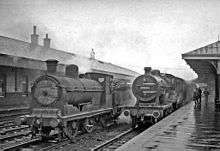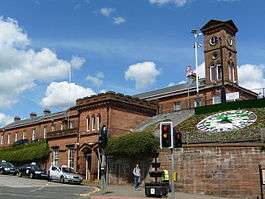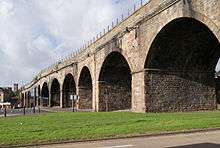Kilmarnock railway station
| Kilmarnock | |
|---|---|
|
Main entrance to Kilmarnock railway station, showing the old ScotRail floral clock which has since been revamped | |
| Location | |
| Place | Kilmarnock |
| Local authority | East Ayrshire |
| Coordinates | 55°36′45″N 4°29′57″W / 55.6124°N 4.4992°WCoordinates: 55°36′45″N 4°29′57″W / 55.6124°N 4.4992°W |
| Grid reference | NS427382 |
| Operations | |
| Station code | KMK |
| Managed by | Abellio ScotRail |
| Number of platforms | 4 |
|
Live arrivals/departures, station information and onward connections from National Rail Enquiries | |
| Annual rail passenger usage* | |
| 2009/10 |
|
| 2010/11 |
|
| 2011/12 |
|
| 2012/13 |
|
| 2013/14 |
|
| 2014/15 |
|
| Passenger Transport Executive | |
| PTE | SPT |
| History | |
| Original company | Kilmarnock and Troon Railway & Glasgow, Paisley, Kilmarnock and Ayr Railway |
| Pre-grouping | Glasgow and South Western Railway |
| Post-grouping | LMS |
| 6 July 1812 | Original station opened by K&TR[1] |
| 4 April 1843 | Original station closed and second station opened by GPK&AR[1] |
| 20 July 1846 | Second station closed and current station opened by GPK&AR[1] |
| National Rail – UK railway stations | |
| * Annual estimated passenger usage based on sales of tickets in stated financial year(s) which end or originate at Kilmarnock from Office of Rail and Road statistics. Methodology may vary year on year. | |
|
| |
Kilmarnock railway station is a railway station in Kilmarnock, East Ayrshire, Scotland. The station is managed by Abellio ScotRail and is served by trains on the Glasgow South Western Line.
History

The first station in Kilmarnock was opened by the Kilmarnock and Troon Railway on 6 July 1812,[1] one of the earliest stations in Scotland. It was replaced by the Glasgow, Paisley, Kilmarnock and Ayr Railway on 4 April 1843.[1] with the opening of their main line from Dalry.
The third and current station was opened on 20 July 1846 by the Glasgow, Paisley, Kilmarnock and Ayr Railway.[1] - this was connected to Ardrossan via Irvine two years later and to Carlisle via Dumfries & Gretna Junction in 1850. The current route to Glasgow (via Barrhead) - the Glasgow and Kilmarnock Joint Railway was completed in 1871 jointly by the G&SWR and Caledonian Railway.
Services on the Irvine branch and via the old main line to Dalry both fell victim to the Beeching Axe in the mid-sixties - the former closed to passengers on 6 April 1964 (and to all traffic in October 1965) and local trains on the latter were withdrawn on 18 April 1966 . Services to the G&SWR terminus at Glasgow St Enoch also ended soon after (on 27 June), with services henceforth running to and from Glasgow Central. The old K&T line also lost its passenger service for several years (local trains ended on 3 March 1969), but these were subsequently reinstated in May 1975 when the boat trains from Stranraer to Carlisle were diverted from their former route via Annbank & Mauchline. The Dalry line remained in use for freight and occasional long distance passenger trains until 23 October 1973, when it was closed to all traffic and subsequently dismantled.
Current operations and station description
The station is built well above street level and is accessed via either a subway and stairs or a more circuitous but step-free route along a narrow access road.
The station has a total of four platforms; two north-facing bays for both terminating Glasgow services and trains on the Glasgow to Stranraer via Kilmarnock route, on which trains reverse out of the station towards the junction with the Troon line. Two through platforms serve through services between Glasgow, Dumfries, Carlisle and Newcastle. The bay platforms (1 and 2) as well as Platform 3 are covered by a partly glazed roof and directly accessible from the ticket office. Platform 4 is used infrequently, accessed via a subway and stairs, and afforded only a bus stop style shelter.
Signalling
The present Kilmarnock signal box is located north of the station, in the vee of the junction. Opened on by British Rail on 12 April 1976, it is a plain brick building containing an NX (entrance-exit) panel on the upper storey. It replaced four mechanical signal boxes in a scheme that saw the track layout greatly simplified. Originally, the box worked Track Circuit Block to Hurlford signal box and Scottish Region Tokenless Block over the single lines to Barassie Junction and Lugton signal boxes. Kilmarnock signal box was severely damaged in a suspected arson attack on 25 December 2006 but was repaired and returned to full operation within weeks.
The train service to Glasgow is partly limited by the single track northwards as far as Lochridge Junction (near Stewarton). This formerly extended all the way as far as Barrhead (with just one loop at Lugton) following track rationalisation in the early 1970s and restricted the frequency of services that could be operated. A "dynamic passing loop" (in effect a redoubling of the section between Lugton and Stewarton) was installed to help rectify this in 2009.[2] The service frequency was increased to half-hourly from the 13 December 2009 timetable change.
New sidings were installed in 2009-2010 along a short section of the trackbed of the old route to Dalry to facilitate the increased coal train traffic.
Kilmarnock railway viaduct
Constructed from 1843 until 1850, the Kilmarnock railway viaduct is a bridge crossing the town centre of Kilmarnock. The bridge begins at Kilmarnock railway station and leads to destinations in England.
It is a most distinctive feature of the town centre with 23 masonry arches. It was built in the 1840s to enable the Glasgow – Kilmarnock line to continue to Carlisle.
At present, the viaduct is currently lit by blue lights when it is dark, which makes it more of a noticeable feature in the town and under-went as part of the Kilmarnock town centre regeneration. The programme carried out on the viaduct was considered a "success".[3]
In April 2012, the bridge's safety had to be upgraded after a man was seriously injured after jumping 40 ft from the top of the railway viaduct.[4]
Kilmarnock station clock
Outside of the railway station, a clock is operated by East Ayrshire Council and Abellio ScotRail. In 2011, the clock received a grant from the Railway Heritage Trust to undergo a regeneration scheme that began in late 2011 and was completed in March 2012.[5]
Services
2013
There is a half-hourly to Glasgow Central for most of the day - journey times can vary between 30–40 minutes depending on the stopping pattern.[6]
The service frequency on the Carlisle line is irregular (10 per day in total), with intervals varying between hourly & 2/3-hourly depending on the time of day, (3 trains extend through to Newcastle), with the last southbound weekday (M-F) service terminating at Dumfries.
On the Ayr line, There is roughly a 2-hourly service (extras during the afternoon) to Ayr & Girvan with 3 extended to Stranraer, There is no Sunday service on this route and passengers for stations to Ayr have to either use Kilwinning (6 miles away) or drive to Ayr, A Sunday service operates in the event of the Ayrshire coast line being closed. Sundays sees 14 services to Glasgow but only two trains to and from Carlisle.
2015-16
The service to and from Glasgow (half-hourly) and Carlisle (ten per day at irregular intervals, three of which continue to Newcastle) remains unchanged, but that to Ayr & Stranraer has been improved, with a train every two hours to the latter from early morning until late evening (nine per day plus three more to Girvan). Sunday service patterns also remain unchanged (half-hourly to Glasgow, 2 to/from Carlisle and no service to Ayr & Stranraer). [7]
Due to Lamington Viaduct on the West Coast Mainline being severely damaged by the Storms of 2015-16, Virgin Trains services from Carlisle were diverted along the Glasgow South Western Line and called at Kilmarnock en route to Glasgow Central. These were irregularly scheduled services and ceased once Lamington Viaduct was repaired and the WCML reopened on 22 February 2016.
Routes
| Preceding station | |
Following station | ||
|---|---|---|---|---|
| Troon | Abellio ScotRail Glasgow South Western Line |
Auchinleck | ||
| Kilmaurs | ||||
| Historical railways | ||||
| Connection with GPK&AR |
Caledonian and Glasgow & South Western Railways Glasgow, Barrhead and Kilmarnock Joint Railway |
Kilmaurs Line and station open | ||
| Hurlford Line open; station closed |
Glasgow and South Western Railway Glasgow, Paisley, Kilmarnock and Ayr Railway |
Crosshouse Line and station closed | ||
| Gatehead Line open; station closed |
Glasgow and South Western Railway Kilmarnock and Troon Railway |
Connection with GPK&AR | ||
Rail & Sea Connections
Trains connect Ayr along the Glasgow South Western Line to Stranraer where a bus link runs, route 350 operated by McLeans (except Sundays) to Cairnryan.[8] for onward ferries to the Port of Belfast by Stena Line and Larne Harbour by P&O Ferries.
Former Ferry Links
Trains also connected along the Glasgow South Western Line to Troon for former the P&O Ferries service to Larne Harbour.
References
| Wikimedia Commons has media related to Kilmarnock railway station. |
Notes
- 1 2 3 4 5 6 Butt (1995), page 133
- ↑ "RAILSCOT - Glasgow and Kilmarnock Joint Railway". railscot.co.uk.
- ↑ "Kilmarnock". dailyrecord.
- ↑ "Kilmarnock News". dailyrecord.
- ↑ http://www.east-ayrshire.gov.uk/CouncilAndGovernment/newsarticle.aspx?p=6406
- ↑ GB Rail Timetable 2013, Tables 216 & 218
- ↑ Table 216 & 222 National Rail timetable, May 2016
- ↑ http://www.dumgal.gov.uk/CHttpHandler.ashx?id=13006&p=0
Sources
- Butt, R. V. J. (1995). The Directory of Railway Stations: details every public and private passenger station, halt, platform and stopping place, past and present (1st ed.). Sparkford: Patrick Stephens Ltd. ISBN 1-8526-0508-1. OCLC 60251199.
- Jowett, Alan (March 1989). Jowett's Railway Atlas of Great Britain and Ireland: From Pre-Grouping to the Present Day (1st ed.). Sparkford: Patrick Stephens Ltd. ISBN 1-8526-0086-1. OCLC 22311137.
- Jowett, Alan (2000). Jowett's Nationalised Railway Atlas (1st ed.). Penryn, Cornwall: Atlantic Transport Publishers. ISBN 0-9068-9999-0. OCLC 228266687.

